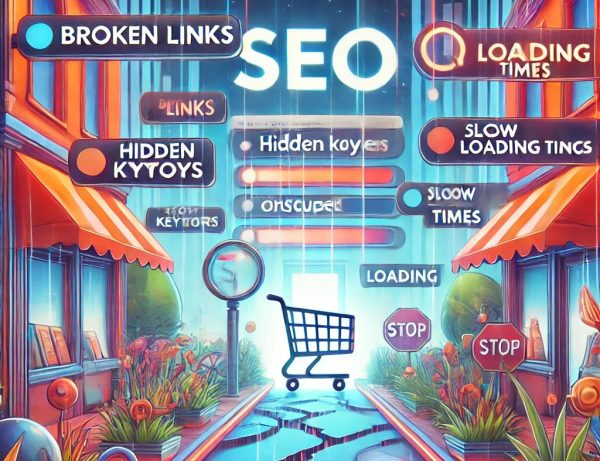Avoid e-commerce SEO mistakes to protect your online store’s visibility and sales. E-commerce SEO drives sales and boosts conversions, yet many businesses fall prey to common pitfalls. The mistakes stifle growth and limit online visibility. Avoid traps; companies’ goal is to boost their digital presence and revenue. The guide covers five pressing e-commerce SEO errors and gives solutions to fix them. Our tips will steer your businesses to thrive in the competitive online marketplace.
E-commerce SEO Mistakes

Why is E-commerce SEO Important?
In the current digital marketplace, e-commerce SEO is vital. It amplifies your online store’s visibility, driving organic traffic and customers to your site. Neglecting SEO could cost you valuable opportunities and diminish your online presence.
Prioritize improving site structure, mobile optimization, and user experience. Our strategies attract more visitors, boost sales, and increase conversions. Embracing e-commerce SEO is smart and vital for growth in a competitive field.
1. Increases Visibility and Organic Traffic
Boost your online business with smart e-commerce SEO. Optimize search engines to climb SERPs and attract more visitors. Start with a thorough SEO audit to identify weak spots in speed, mobile design, and keyword use. Track progress using analytics tools to see what drives traffic and sales. For better search performance, Fine-tune meta tags, product descriptions, and site structure.
2. Boosts Sales and Conversions
Want to boost sales? Optimize your e-commerce site. Better visibility and user-focused design turn browsers into buyers. Use compelling calls-to-action and tailored product suggestions to engage shoppers. Customer reviews build trust and community. A/B tests different approaches to refine your strategy. The result? More conversions, higher sales, and loyal customers who keep returning for more.
All of the mistakes we mention and suggestions we make require precision, practice, and time to correct. Studies show that reaching out to an SEO expert, even for advice, substantially increases click-through rates and customer visits.
The button will redirect you to the Upwork freelance platform, where you can schedule 30-minute consultations for $30 or 1-hour consultations for $60.
The 5 Biggest E-commerce SEO Mistakes
Fundamental SEO missteps derail online businesses. Many companies unknowingly sabotage their visibility, missing out on vital organic traffic. From poor keyword analysis to neglected on-page elements, the mistakes tank rankings and shatter links. Such oversights cost you dearly in missed sales. Stay vigilant in the digital sphere- your e-commerce success depends on it.
1. Not Optimizing Product Pages for Keywords
Neglecting keyword optimization for product pages cripples e-commerce SEO. Without thorough research, visibility plummets, shrinking your audience and sales potential. The errors hurt your online presence. Search engines favor quality, intent-matching content.
Seamlessly integrate researched keywords into product descriptions. Boost on-page SEO with alt text for images and strategic header tags. It improves accessibility for users and search engines alike.
For best results, target long-tail keywords. Use natural language that captures the product’s essence and meets the audience’s needs. Rank the elements to advance your e-commerce strategy and outpace competitors in search rankings.
2. Neglecting On-Page SEO Elements
Ignoring required on-page SEO elements will cripple your e-commerce site’s success. Poor title tags, meta descriptions, and internal links hurt search rankings. It cuts organic traffic. The ripple effect dampens engagement, sales, and user satisfaction.
Think of title tags as digital storefront signs. Craft them to reflect content and entice clicks. Meta descriptions? Your elevator pitch. Make them unique, concise, and irresistible.
Revisit your site structure. Link related pages strategically to improve navigation and distribute page authority. The simple step amplifies your SEO impact.
Remember: neglecting elements means missed opportunities. Optimize wisely to climb rankings, boost traffic, and heighten your e-commerce game. Your site’s performance hangs in the balance.
3. Ignoring Technical SEO Issues
Technical SEO despairs cripple your e-commerce site’s success. Slow speeds, broken links, and chaotic structure lead to high bounce rates and lost conversions. Poor optimization hurts search rankings, making your store harder to find. Lagging sites frustrate shoppers, causing abandoned carts. Lack of HTTPS erodes user trust.
But there’s hope. Analytics tools reveal performance issues, allowing swift fixes. Use tools to tackle the problems, you create a smooth, secure browsing experience. A well-organized site guides visitors effortlessly through their shopping trip.
Don’t let technical oversights sabotage your e-commerce goals. Prioritize site speed, fix broken links, and streamline your structure. Secure your connection with HTTPS. Use analytics to pinpoint weak spots. Your efforts will pay off in higher rankings, increased trust, and, ultimately, more sales.
4. Not Having a Mobile-Friendly Website
Mobile-unfriendly websites drive away potential customers. As smartphone shopping surges, optimizing for mobile is very important. Ignoring it leads to poor user experiences, high bounce rates, and lost sales. Prioritize responsive design, intuitive navigation, and swift image loading. Streamline checkouts, limit pop-ups, and use legible fonts. The improvements boost traffic and conversions. Customers are more likely to complete purchases when sites are easy to find on phones. Don’t let poor mobile design cost you sales in today’s mobile-first e-commerce world.
5. Not Utilizing Local SEO Strategies
Neglecting local SEO tactics? You’re likely missing vital connections with nearby customers. For area-specific businesses, it means lost chances to attract clients and build a community presence.
Weave local keywords into your site’s content and metadata to boost visibility in nearby searches. Use schema markup to clarify content for search engines. It will increase users’ information and clicks.
Precision targeting builds trust and improves brand recognition. It is paramount to lasting success. It attracts the right audience and secures your local market position.
Don’t underestimate the power of local SEO. It’s your way to open community engagement and sustainable growth.

How to Avoid The Mistakes
Sidestep e-commerce SEO pitfalls by embracing best practices head-on. Research deep into keyword research, fine-tune on-page elements and iron out technical wrinkles. The strategy readies your online store for great search performance and success.
1. Conduct Keyword Research for Product Pages
Keyword research jumpstarts effective e-commerce SEO. Target long-tail gems to boost product visibility and attract ideal customers. Leverage Google Analytics or SEMrush for insights into search trends and user behavior. Uncover high-potential keywords and competitor gaps. Analyze rival strategies to adapt your approach with similar niche phrases.
It will improve product discoverability and align with shoppers’ search intent, potentially increasing conversions. The tactics will also assist you to avoid SEO pitfalls and optimize your product pages for success.
2. Optimize On-Page Elements (Title Tags, Meta Descriptions, etc.)
Boost your e-commerce site’s visibility with smart on-page SEO. Craft concise title tags under 60 characters, including relevant keywords. Write compelling meta descriptions of 150-160 characters to entice clicks. Use strategic internal linking. It will improve user experience and signal page importance to search engines.
The elements influence indexing, search results display, and click-through rates. A well-optimized site structure boosts user engagement and search performance. It drives more traffic to your online store.
3. Regularly Check and Fix Technical SEO Issues
Technical SEO issues demand vigilant attention. Swift resolution keeps e-commerce sites humming smoothly. From speed to user experience, the factors shape overall site health. Slow-loading pages frustrate visitors, causing them to bounce. Broken links disrupt navigation, driving potential customers away.
Regular SEO audits pinpoint pressing elements, assuring accessibility and efficiency. Monitoring site speed and link functionality improves user experience and search rankings.
Tackling problems promptly maintains a well-oiled digital storefront. The approach boosts user experience and urges visitors to stay, explore, and buy. E-commerce sites may thrive in a competitive online marketplace by prioritizing technical SEO.
4. Assure Your Website is Mobile-Friendly
Mobile optimization is required for e-commerce success. It improves user experience, impacts traffic sources, and boosts conversions. With most browsing done on smartphones, responsive design is fundamental. Sites must adapt to various screen sizes seamlessly.
Fast loading times are vital. Slow sites risk higher bounce rates and customer frustration. Google’s Mobile-Friendly Test offers insights for improvement.
An intuitive mobile experience engages users and improves SEO. Search engines favor mobile-accessible sites. Prioritizing mobile friendliness isn’t optional—it’s indispensable for thriving.
5. Implement Local SEO Strategies
Local SEO is your secret weapon for attracting nearby customers. Target your audience precisely and build community trust with smart strategies. Use local keywords to appear in nearby searches. A well-maintained Google My Business listing boosts visibility and shares key info. Positive customer reviews improve credibility and influence decisions. The tactics align with Google’s local-friendly algorithms. They make your business easier to find and connect with. If you optimize locally, you’ll stand out in your community and draw in more potential customers.

